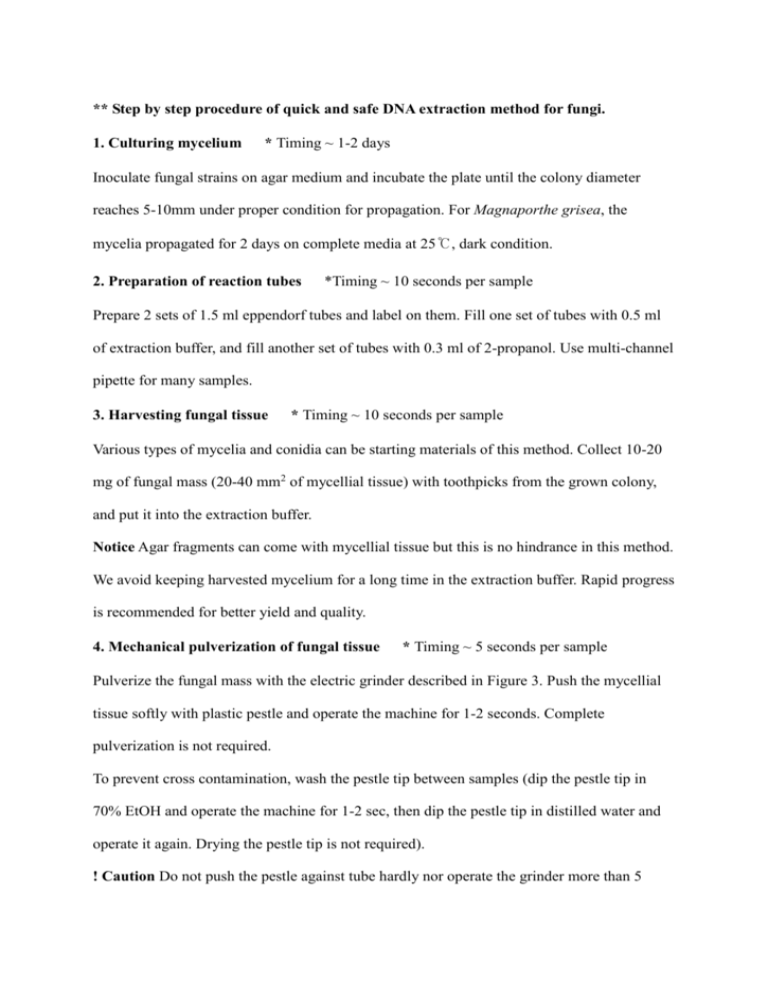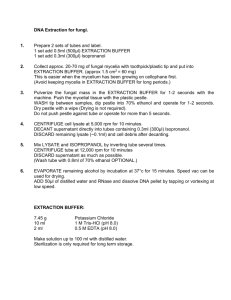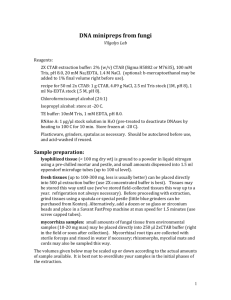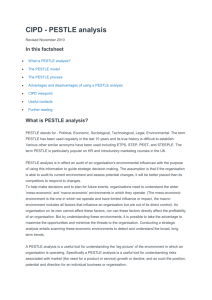Step by step procedure of quick and safe DNA extraction method for
advertisement

** Step by step procedure of quick and safe DNA extraction method for fungi. 1. Culturing mycelium * Timing ~ 1-2 days Inoculate fungal strains on agar medium and incubate the plate until the colony diameter reaches 5-10mm under proper condition for propagation. For Magnaporthe grisea, the mycelia propagated for 2 days on complete media at 25℃, dark condition. 2. Preparation of reaction tubes *Timing ~ 10 seconds per sample Prepare 2 sets of 1.5 ml eppendorf tubes and label on them. Fill one set of tubes with 0.5 ml of extraction buffer, and fill another set of tubes with 0.3 ml of 2-propanol. Use multi-channel pipette for many samples. 3. Harvesting fungal tissue * Timing ~ 10 seconds per sample Various types of mycelia and conidia can be starting materials of this method. Collect 10-20 mg of fungal mass (20-40 mm2 of mycellial tissue) with toothpicks from the grown colony, and put it into the extraction buffer. Notice Agar fragments can come with mycellial tissue but this is no hindrance in this method. We avoid keeping harvested mycelium for a long time in the extraction buffer. Rapid progress is recommended for better yield and quality. 4. Mechanical pulverization of fungal tissue * Timing ~ 5 seconds per sample Pulverize the fungal mass with the electric grinder described in Figure 3. Push the mycellial tissue softly with plastic pestle and operate the machine for 1-2 seconds. Complete pulverization is not required. To prevent cross contamination, wash the pestle tip between samples (dip the pestle tip in 70% EtOH and operate the machine for 1-2 sec, then dip the pestle tip in distilled water and operate it again. Drying the pestle tip is not required). ! Caution Do not push the pestle against tube hardly nor operate the grinder more than 5 seconds. Frictional heat may damage the tube or pestle tip. Do not operate the grinder without protecting cap. Spinning pestle may be rushed out. 5. Elimination of cell debris and contaminants * Timing 10 minutes and additional 10 seconds per sample Centrifuge cell lysate at 5,000 rpm for 10 minutes. Decant supernatant directly into the tubes filled with 2-propanol which were prepared in Step 2. Discard remaining lysate (~ 0.1 ml) and cell debris after decanting Notice Some debris can come with supernatant but this is no hindrance in this method. 6. DNA precipitation * Timing 10 minutes and additional 10 seconds per sample Mix the lysate and 2-propanol by inverting the tube several times. Centrifuge the tube at 12,000 rpm for 10 minutes. Discard the supernatant as much as possible. (Optional: Wash the tube with 0.8 ml of 70% EtOH) Notice Centrifugation is the most time-consuming procedure in this method. Using several centrifuges is recommended when managing many samples. 7. Dissolving DNA pellet * Timing 15 minutes and additional 5 seconds per sample Evaporate remaining alcohol by incubation at 37℃ for 15 minutes. Add 50 µl of distilled water or 1x TE and dissolve the DNA pellet by tapping or vortexing in low speed. Complete desiccation is not required because remaining solution include no alcohol after 15 minutes incubation. Using desiccator or freeze drier may reduce the drying time. We avoid keeping the extracted DNA for a long time. Prompt application to PCR or restriction enzyme digestion is recommended. Reagents - Potassium chloride (1630-7250, Showa) - 1M Tris-HCl (pH 8.0) - 0.5M EDTA (pH 8.0) - 2-propanol (K36633934, Merck) - Ethanol (K37060983, Merck) Equipment - Growth medium (dependent on fungal species) - Wooden toothpicks - 1.5ml eppendorf tubes - Electric grinder (see figure 1) - Microcentrifuge (Micro17TR, Hanil science industrial) Preparation of extraction buffer Timing is ~ 5 m. The composition of extraction buffer is 1M KCl, 100mM Tris-HCl, 10mM EDTA. For 100ml of extraction buffer, dissolve 7.45g of potassium chloride into distilled water, add 10ml of 1M Tris-HCl (pH 8.0) and 2ml of 0.5M EDTA (pH 8.0), and adjust volume up to 100ml with distilled water. Sterilization is required only for long-term storage. Figure 1. Correlation between mycelial mass and amount of total DNA extracted with the QS method. Amount of total DNA was calculated by determining absorbance of DNA solution at 260 nm. The regression equation was generated from 51 samples in total. Figure 2. Examples of DNA samples from the QS method and their application in PCR reaction and Southern hybridization. (A) DNA samples extracted from different transformants of Magnaporthe oryzae. One microliter of DNA solution (out of 50 µl) for each sample was electrophoresed on a 0.7% agarose gel. (B) Results of PCR amplification using DNA prepared by QS method. Five microliter of each PCR product (out of total 10 µl) was visualized. The 2 kb band indicates wild type allele and 4 kb band indicates mutant allele. (C) Comparison of Southern hybridization result between DNA samples from conventional method and QS method. One microgram of genomic DNA from 4 different transformants (TF#1-4) isolated by each method was digested with XhoI, BamHI and SacI. Odd lanes are result of conventional method and even lanes are result of QS method. Figure 3. Inner structure of electric grinder.








